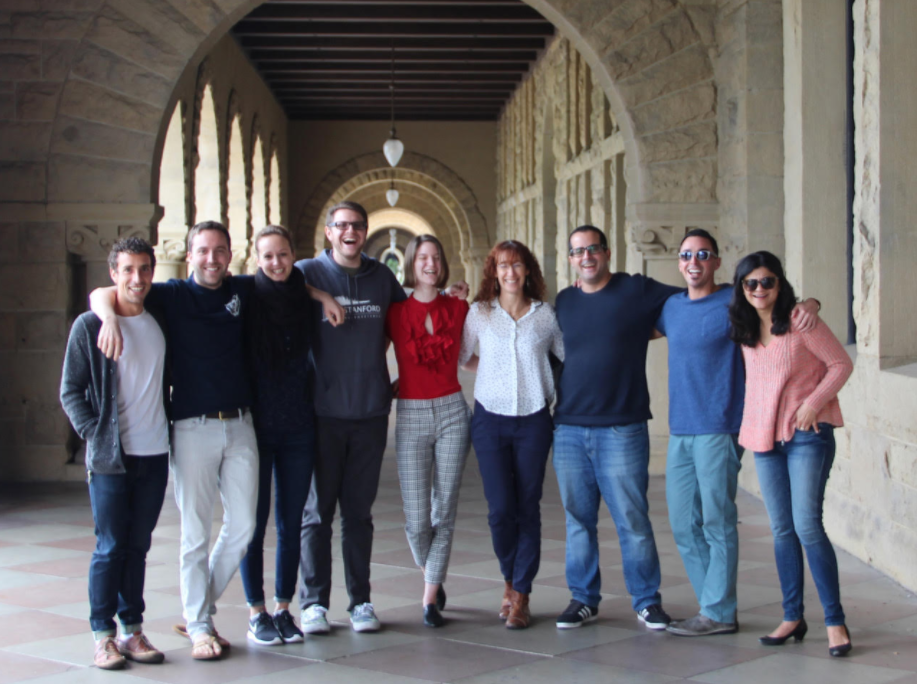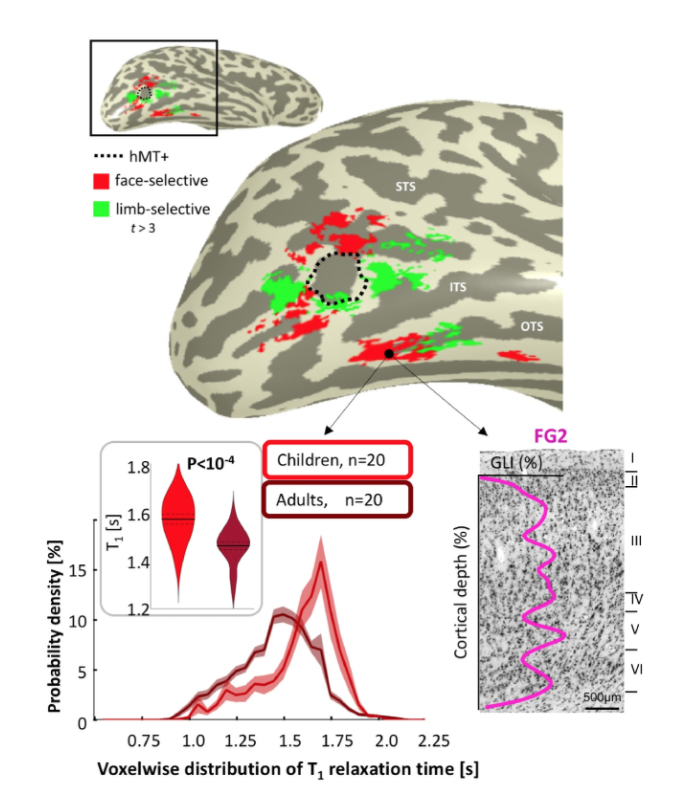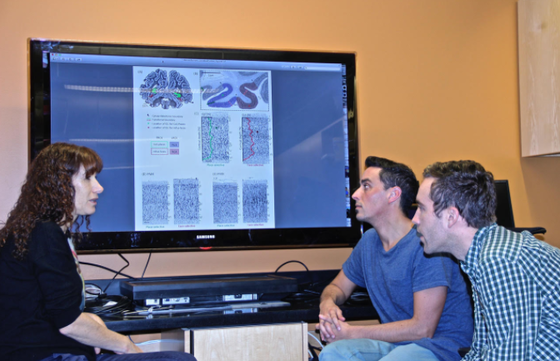|
BY THOMAS YEO --- See Kalanit Grill-Spector's OHBM2017 keynote lecture here: https://www.pathlms.com/ohbm/courses/5158/video_presentations/76037 --- Professor Kalanit Grill-Spector is the principal investigator of the Vision and Perception Neuroscience Lab at the Department of Psychology and the Stanford Neuroscience Institute at Stanford University. She will give a much anticipated keynote lecture at the upcoming 2017 OHBM Annual Meeting at Vancouver. We caught up with Professor Grill-Spector to discuss her illustrious research career. Thomas Yeo (TY): Imagine that you meet some random person off the street. How would you describe your research to the person? Kalanit Grill-Spector (KGS): The core of my research is figuring out how the brain enables us – as humans – to understand what we see. Therefore, my research examines how the function, anatomy, and computations of the parts of the brain that are involved in visual processing relate to visual perception. Additionally, I am interested in uncovering how these parts of the brain develop from childhood to adulthood and what aspects of this development are shaped by experience. TY: How did you end up on this research path? KGS: I first studied electrical engineering and computer science (CS). However, when I started working as an engineer, I did not like it. Then, I discovered the fascinating world of vision science by reading a Scientific American article by Semir Zeki in 1992. I thought, “I want to study this too!” Someone told me that there is a group in the Weizmann Institute of Science that works on Computational Vision. I asked to audit a seminar jointly run by professors in CS and Neurobiology. One of the meetings was devoted to a Nature paper by Fujita and colleagues from Tanaka and Cheng’s group: Columns for visual features of objects in monkey inferotemporal cortex. The CS and Neurobiology researchers were so passionate in their heated discussions that I got hooked. I wanted to be part of something that was obviously important. So, I applied to the graduate school at the Weizmann Institute of Science. I started my scientific career in computational modeling of orientation columns in V1 with Shimon Edelman and Rafi Malach. During this process, Rafi returned from a sabbatical at MGH (Boston), and said “there is this new thing called functional magnetic resonance imaging (fMRI)”. No one at Weizmann believed him that it was going to be a worthwhile research direction, but Rafi had a vision and was both energetic and stubborn. So, armed with energy and determination, Rafi and I set out to develop the first fMRI system in Israel. I think we would all agree that it turned out to be successful after all…
TY: What is the most exciting thing your lab is working on now? KGS: C’mon, if I’m spending time working on projects, obviously, they are all exciting to me! But, if you had to twist my arm, Thomas, there are two things that perhaps I’m the most excited about. One is integrating many types of anatomical and functional in-vivo neuroimaging measurements within individual brains to understand the interplay between structure, function, and behavior, especially in the context of development. The second is developing the next generation of computational encoding models of the visual system with the goal of predicting cortical responses resulting from both bottom-up and top-down inputs. TY: Moving forward, what do you hope your research will accomplish in the next 10 years? KGS: I am hopeful that we will make big strides in three domains: (1) Understanding the structural and functional development of the ventral visual stream and in particular which aspects of development are shaped by experience. (2) Elucidating the anatomy of the visual system. We are far behind in understanding the anatomical constraints underlying the function of the visual system. For example, we do not even have a wiring diagram of the white matter tracts in the visual system in the human brain. (3) Developing precise computational models of the visual system based on empirical functional and anatomical measurements in humans. The development of such models will hopefully help us understand how the brain perceives and recognizes the visual input. TY: Can you give us a teaser or preview of your OHBM keynote lecture? KGS: In the lecture, I will address a central neuroscience question: how do brain mechanisms develop from childhood to adulthood to enhance behavior? I will use the ventral visual stream as a model brain system to address this question, and present data addressing two main developmental hypotheses: pruning and growth. Since this is OHBM, I will underscore how recent advances in multiple non-invasive neuroimaging approaches give us – as a field – a powerful toolkit to study how the development of brain function and structure relates to behavioral development. TY: What do you think is the most exciting development that is happening in your area or the broader field of neuroscience. KGS: In my field, computational and anatomical advancements have made a big impact. One hot area is combining neuroimaging measurements of brain function with computational (encoding) models that not only predict brain responses, but also explain the underlying computations. The second is significant advancement in anatomical methods including quantitative MRI and diffusion weighted imaging as well as improved analysis tools to define tracts and determine cortical networks. While fMRI has significantly advanced our ability to map human brain function, we still know very little about the underlying anatomy. TY: Who are the people that have inspired you throughout your career?
KGS: The people who have inspired me and continue to inspire me are those that push me in new directions. For example, Rafi Malach (my PhD adviser) taught me how to ask – and answer – big questions with enthusiasm and attention to detail. Brian Wandell (at Stanford) is an excellent mentor who continuously makes it clear that the gold standard for good research is one that can be articulated in precise quantitative and reproducible terms. My students, who have taken me on new paths. In particular, Kevin Weiner, who took me on a successful trip down neuroanatomy lane (I’d never have thought that I’d drive there) and Jesse Gomez, who has introduced new and neuroimaging methods to the lab. TY: What is the biggest challenge that you have experienced in your research career? KGS: One of the biggest challenges I have experienced as a young researcher was coping with adversarial reviews of papers and grants. For example, one of my most cited papers is my 1999 Neuron paper about fMRI-adaptation. However, the first round of reviews was tough to handle. Some parts of the review were insulting, for example, a reviewer wrote that our findings were mundane. Other parts were so nasty that we don’t even know what the reviewers wrote as the editor blocked them out with a black marker. As a young researcher, I can tell you that this review really shattered my confidence. Critically, however, this early experience made me learn fast that to become a scientist, you not only have to be determined, but you also need to develop thick skin. So, while this and other challenges have affected me, it didn’t deter me from staying on this great path of scientific discovery. TY: What advice would you give to aspiring researchers? KGS: Neuroimaging today is an increasingly computational field, so I have two main pieces of advice. First, you should really learn how to code. You need to be able to understand, own, and develop your research tools. Importantly, being able to code will also help you do reproducible research. Second, inspect your data, not just the summary statistics – from individual participants’ data, to individual brain anatomies, even individual voxels in each participant. Computational tools and automation do not prohibit close contact with your data. On the contrary. This type of approach has helped me understand the consistent and variable aspects of the data across participants and also flag artifacts that otherwise would have been missed. We thank Professor Grill-Spector for her time in answering these questions. We look forward to attending her exciting keynote on “Brain Growth and the Development of Face Recognition” on Monday 9.30am at Ballroom AB.
0 Comments
Your comment will be posted after it is approved.
Leave a Reply. |
BLOG HOME
Archives
January 2024
|



 RSS Feed
RSS Feed